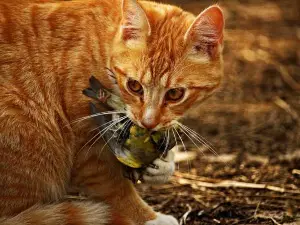
Regardless of how cute and cuddly cats are, these animals are natural predators to small animals like birds.
If your cat caught a bird, and the bird is still alive, you’d likely be concerned. This article explores why cats hunt birds and what to do if your cat hunts and catches a bird.
My cat caught a bird and it’s still alive
Because cats have a natural instinct to hunt and kill, a large percentage of wildlife, birds included, are killed by cats.
Cats can be very ferocious hunters and killers. When cats hunt their prey, they create small puncture wounds with their sharp teeth creating incisions in the throat of their prey. The incisions that cats make in birds are usually fatal.
In addition, cat mouths are filled with infectious organisms. When birds are bitten, these infectious organisms will transfer from the cat’s teeth into the bird’s body.
These organisms will get into the bird’s bloodstream and can kill the bird. This can be a slow death, birds attacked by cats can die within 4 hours if they are not given antibiotic therapy.
Birds who are attacked by cats can die of septicemia. Cat attacks can also cause birds to develop internal bleeding, birds can die from this as well.
If you’re worried about your cat:
If your cat caught a bird, you don’t have to be worried about your cat or yourself becoming sick as a result of being exposed to the bird.
There is nothing to worry about unless there was a large amount of close contact between the bird and the cat.
You’d only need to worry if the bird produced droppings that you or your cat came into contact with. In this case, you’d need to disinfect to keep your home clean.
What to do with a bird that your cat caught?
A cat’s teeth can do some real damage to a bird, if the bird is bleeding a lot then the bird may die of blood loss or shock. The shock may kill the bird before its wounds do.
The best thing you can do for the bird is to take the animal to a vet or to a wildlife rehabilitation center to be attended to.
You need to contain the bird in a solid box as you travel. It is also recommended that you place a heating pad or a bottle filled with hot water under the box to keep the bird warm.
If you only have a clear container available, cover at least 3 sides of the container with a towel to limit visual stimulus for the bird
The professionals at the vet, or at the wildlife rehabilitation center, will start off by calming the bird and getting it out of its shocked state.
The bird will then be given painkillers, subcutaneous fluids, and antibiotics to help with the healing. After this, the bird will be given time to rest and heal.
If the people at the vet, or at the wildlife rehabilitation center, realize that the bird is not recovering then they will euthanize it to keep it from suffering anymore.
What to do in the mean time:
If you’re still waiting for the vet appointment, or if you can’t immediately take the bird to a wildlife rehabilitation center, then you’d need to keep the bird safe from other predatory animals.
If you leave the bird outside, predators will likely come along and eat the bird. Keep the bird safe by putting it in a small solid container or in a small dark space where predators cannot get to it.
Keeping the bird somewhere isolated and dark is also helpful because it will allow the bird to calm down. Don’t try to interact with the bird for at least 12 hours, allow it to calm down on its own, you checking up on it may scare it.
If the bird is not severely injured, then the bird will likely recover on its own and fly away after coming out of its shocked state.
If you enjoyed this article then you may also be interested in other bird related articles. Here are some articles that you may be interested in: Bird Twitching Head, Bird Floppy Neck, How To Tell If A Birds Neck Is Broken, Bird Not Flying Away

